#medieval ivory
Text

Ivory Plaque with Enthroned Mother of God ("The Stroganoff Ivory"), 950–1025. Byzantium, Constantinople, Byzantine period. Ivory; overall: 25.3 x 17.2 x 1.8 cm (9 15/16 x 6 3/4 x 11/16 in.). The Cleveland Museum of Art, Gift of J. H. Wade 1925.1293
#CMA#Stroganoff Ivory#Virgin and Child#medieval ivory#medieval ivories#Byzantine ivory#Byzantine ivories
94 notes
·
View notes
Text


Medieval ivory wall panels depicting the lives of Jesus and Godzilla.
209 notes
·
View notes
Text
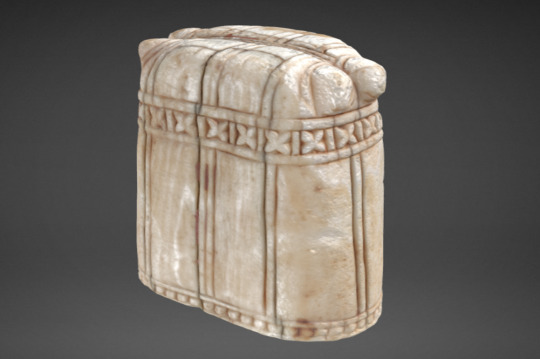
Medieval chess, or medieval Kinder Surprise?
As mentioned in the previous post, chess originated in India and early chess boards often included a bishop. When the game was popularized in northern Europe, the original pieces continued to be used, although they lost their meaning or were reinterpreted over time. The elephant's tusks eventually became two bumps. Eventually, elephant, chariot, and vizier pieces were given names of officials at northern courts: bishops, knights, and queens. These transitions and designs happened in different ways in different places.
An interesting piece that showing one moment of transition, acquired by Musée de Cluny in 2011, has the abstract elephant shapes with bumps on the outside-- plus a surprise bishop holding a crozier and a book on the inside!
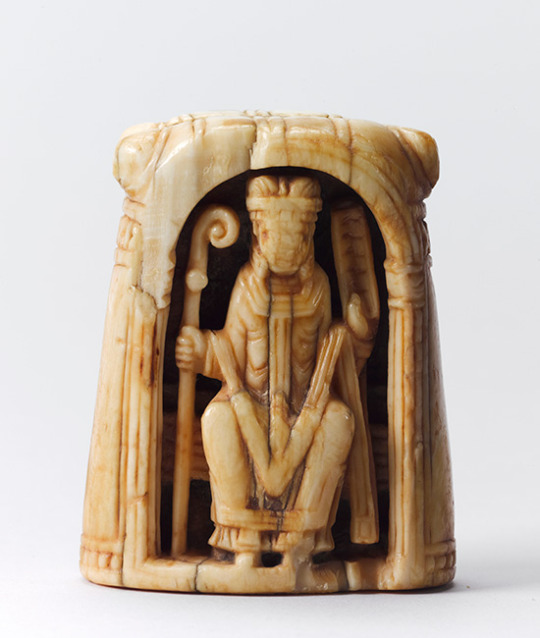
Material: Ivory
Date: 12th century?
Origin: Cologne? England?
Now Paris, Musée de Cluny Cl. 23885
You can play with a 3D version at https://www.musee-moyenage.fr/collection/collections-3D/piece-d-echec-eveque-en-3d.html
#elephant#elephants#medieval elephants#ivory#chess#chess piece#bishop#musee de cluny#12th century#middle ages#global middle ages
193 notes
·
View notes
Text
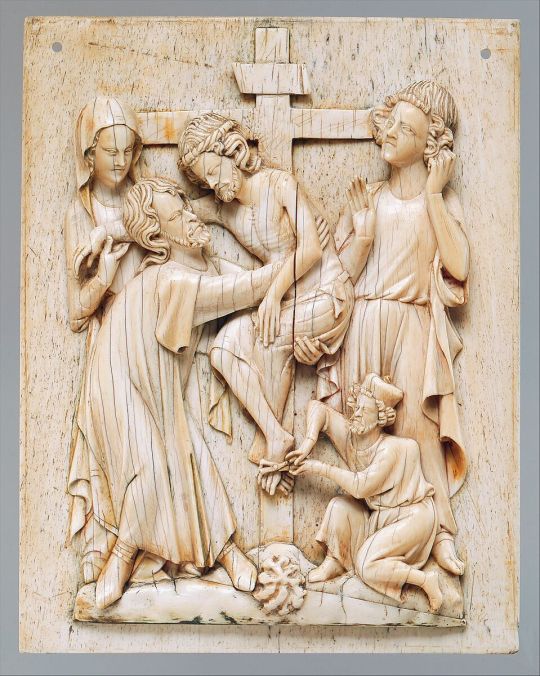
Ivory Plaque with the Descent from the Cross, French, ca. 1320-1340
48 notes
·
View notes
Text
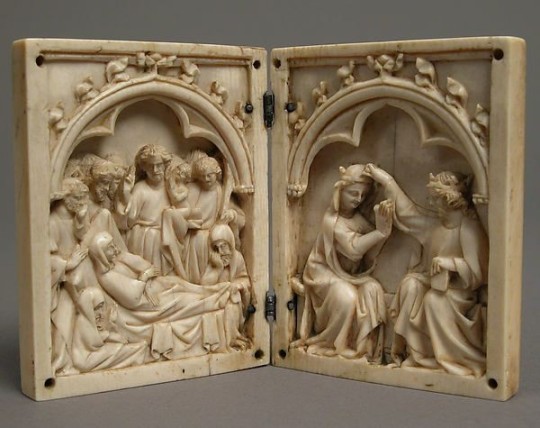
Diptych with the Death and Coronation of the Virgin. Fransh. The MET c. 1330-1350
96 notes
·
View notes
Text

The ever stylish @ladyamaranthine
#gothic style#gothic beauty#gothic elegance#beauty#lady amaranth#ivory#long black hair#burgundy velvet#medieval style gown#bell sleeves#burgundy chiffon#burgundy satin#cemeteries#faded grandeur
22 notes
·
View notes
Text
everybody says fire emblem three houses is a good game but they do NOT talk about how after you play there becomes a real danger of a medieval art history phd. we should be talking about how fe3h aims to convince the youth of today to get a medieval art history phd.
#caught myself looking at medieval art history requirements @ [redacted university] again.#thru tears: reliquaries.............ivories.............hagiography........MANUSCRIPTS#rambles#fe3h#in fe3h's defense i already liked medieval art history i just have spent more time w it recently . :|
10 notes
·
View notes
Text

Nativity, Paris, ca. 1250-1260, ivory, Louvre Museum.
31 notes
·
View notes
Text
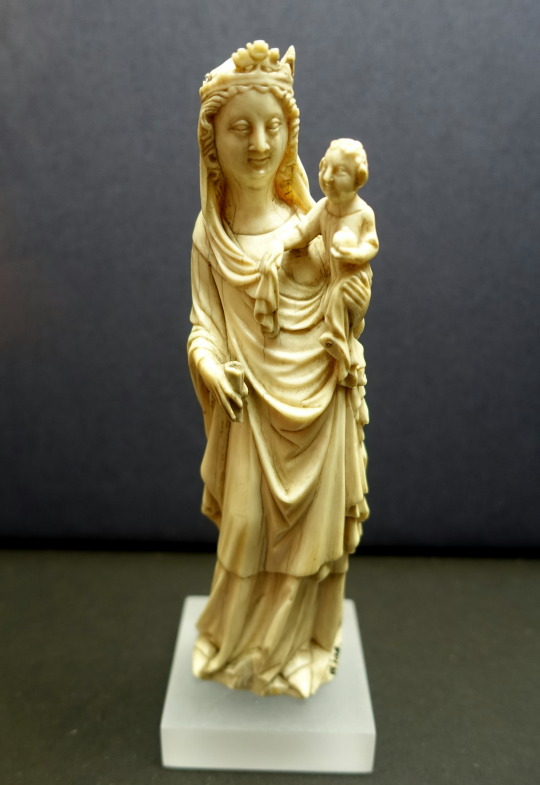
The Virgin Mary with the infant Jesus. Ivory statuette by an unknown artist active in the Rhineland, 14th century. Now in the Museum Schnütgen, Cologne, Germany.
#art#art history#Middle Ages#medieval#medieval art#sculpture#statuette#ivory#carving#religious art#Christian art#Christianity#Virgin and Child#Madonna and Child#German art#14th century art#Museum Schnutgen
89 notes
·
View notes
Photo

This box is ivory on a wooden armature, painted and gilded; you can’t really tell except from the one image on the side that the adornment was mainly birds, given how worn it is. It’s a pretty piece but I’m including it here because in translation the title for it is “Box of Birds and Peacocks” which is going to be the title of my YA fantasy novel if I ever get round to writing one. Even better, the arabic writing on the box apparently translates to “Perpetual Glory” which is a great battle slogan for my YA fantasy protagonists.
[ID: A four-sided ivory box, rather like a shoebox with an angular domed lid; it is pale cream with round inset decorations that once depicted birds but are now mostly worn away. On one end is a non-worn depiction of a peacock strutting. There is a heavy metal clasp on the front and a ring on the top, presumably for carrying.]
29 notes
·
View notes
Text

He is Risen!
Three Maries at the Sepulchre. 10th C ivory, possibly carved at St Gallen. V&A #380-1871.
3 notes
·
View notes
Text


Ornate medieval ivory combs with Godzilla imagery.
99 notes
·
View notes
Text

The elephant's gambit
The layout of the chessboard that Europeans know today-- with rooks, knights, bishops, queens, and kings-- was not the original line-up. The game of chess is reputed to have orginated in India, and spread via the Middle East to Europe. According to the Persian poet Ferdowsi, early chess sets involved a king, vizier, elephants, calvary, chariots, and infantry. (See the Met's Spring 1975 Bulletin).
Today this 7th- or 8th-century chess piece is held at the Met Museum, where it is still categorized as... a bishop.
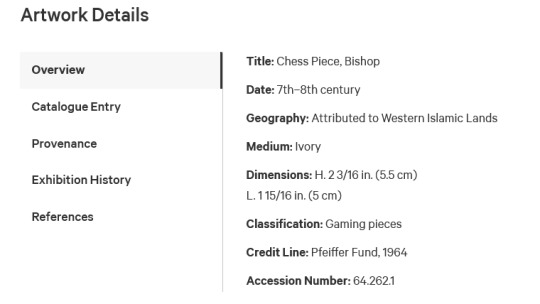
Stay tuned tomorrow for how the elephant became a bishop!
Medium: Ivory
Date: 7th–8th century
Origin: Western Islamic lands?
Now Met Museum, 64.262.1
25 notes
·
View notes
Text

Ivory Diptych with Scenes from the Passion and Afterlife of Christ, French, ca. 1330-1350
25 notes
·
View notes
Text
Storming the Castle of Love

Ivory mirror-case, 14th C. V&A Museum.
Knights attack the Castle of Love 'defended' by women, who ardently receive the knights when they climb over the battlements.”

“ The subject of the Siege of the Castle of Love appears frequently on secular ivories in the fourteenth century; the Museum owns two other mirror cases and a casket bearing similar representations. An allegorical siege of the Castle of Love seems to have been frequently enacted during the Middle Ages; the thirteenth century chronicler, Rolandino of Padua, for instance, records a festival in the town of Treviso in 1214 where a castle was built, and defended by the women and girls of the town while being attacked with fruits, perfumes and flowers thrown by the men. This is the earliest known account of such a siege and Rolandino only records it because it ended in disaster, with violence breaking out between knights from Padua and Venice who were contesting the castle gateway; there may have been any number of precedents which went unrecorded. This type of festivity remained popular for several centuries. We know that the marriage of Henry VII's son, Prince Arthur, in 1501, was celebrated with a Masque of the Mount of Love besieged by knights, and a similar pageant took place regularly in Fribourg up until the eighteenth century. The sources of the subject are obscure, but it may have been derived from a now-lost romance or an oral tradition. Thomas M. Green, in his overview of the 'Castle of Love' topos, ( Besieging the Castle of Ladies: Occasional Papers/Center for Medieval & Early Renaissance Studies, no.4, Pegasus Press, 1994), writes that the oldest castle of women known to him appears as a foundation myth of the city of Prague in the chronicle of Cosmas of Prague, composed early in the twelfth century.”
https://collections.vam.ac.uk/item/O120162/storming-on-the-castle-of-mirror-case-unknown/
10 notes
·
View notes
Video
youtube
Depicting Judaism in a medieval Christian ivory, January 2, 2023
Plaque with the Crucifixion and the Holy Women at the Tomb, c. 870 (Carolingian, likely Metz), ivory, 23.8 x 12.3 x 0.6 cm (Met Cloisters and Musée du Louvre)
Speakers: Dr. Ariel Fein and Dr. Steven Zucker
Smarthistory
The figures on this late Carolingian plaque are carved in a stately style and are defined by simple, linear draperies. Because of its size, format, and the nature of its subject, this plaque most likely served as the central decoration on the front cover of an evangelary. It depicts an allegorical crucifixion, a common theme in Metz ivories. Above the cross are bust-length personifications of the sun and the moon. From Christ's right side flows a stream of blood and water, which is caught by a personification of the Church. To the immediate right of Christ is the hooded figure of Synagogue, her body turning away. The entire group is flanked by the Virgin and St. John, executed in larger scale. Below them are Longinus with his lance, Stephaton with the sponge, and figures emerging from circular mausolea, a reference to the resurrection of the dead at the Last Judgment. The snake spiraled around the foot of the cross symbolizes Christ's triumph over death and evil. In the lower register, the three Maries appear at the tomb of Christ, a scene which is rarely combined with the Crucifixion in Carolingian art.
Collection of the Metropolitan Museum of Art
#Christianity#Judaism#medieval#art#art history#religion#ivory#relief#9th century#Carolingian Empire#The Met#Metropolitan Museum of Art#Musee du Louvre#figure#allegory#Metz#French#personification#Smarthistory#Louvre Museum
2 notes
·
View notes